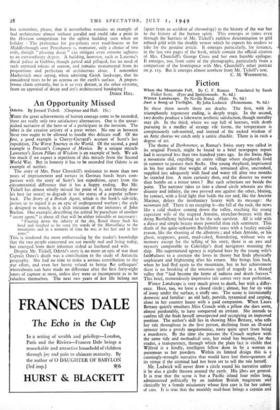On Architecture
Buildings and Prospects. By John Piper. (Architectural Press. 18s.)
ONCE the reader has penetrated beyond the volcanic ashes that fall dismally on the buildings and prospects pictured on Mr. Piper's dust-jacket, he will find that the text in no way reflects this sombre, if dramatic exterior. The pen of the " foul weather Jack " of our contemporary pictorial scene is less charged with cataclysmic fore- bodings than his brush, and Mr. Piper's writing is as entertaining in its descriptions as it is clear in its topographical details. The engraving shown of Winstanley's Eddystone is called " a kedgeree of bits and pieces," while the Peacehavens and Fcrrings " are the out- flows of giant waste pipes that-carry down some of South London without making it suffer any sea change." Excellent ; and we shall take a much needed lesson from Mr. Piper's scorn of such architec- tural failures. Likewise from his essay Fully Licensed any civic- minded citizen should deplore the pulling down of gin-palaces with their " snob screens " and mirrors of " brilliant cut " glass to mak.: way for the road-houses of jazz linoleum and chromium plate. But from some of Mr. Piper's essays, especially that on Pugin's St. Marie's Grange, the unenlightened would do well to be warned.
I have known the house that Pugin built from childhood, and it seems no less hideous today as a private hotel, open to non-residents, than it did when inhabited by family friends. It may be amusing to think of it as a suitable residence for John Betjeman's Joan Hunter- Dunn or indeed for a girls' school presided over by Arthur Marshall,
but remember, please, that it nevertheless remains an example of bad architecture almost without parallel and could take a prize in the Horizon competition for the ugliest building seen when on holiday • The preference for gin-palaces over road-houses or for Middlesbrough over Peacehaven is, moreover, only a choice of two evils, though " pleasing decay " can mitigate even extreme ugliness to an extraordinary degree. A building, however, such as Laurana's ducal palace in Gubbio, though gutted and pillaged, has no need of such outward tokens of sorrow, and remains monumental from its proportions and perfection of architecture alone. I remember Markevitch once saying, when admiring Greek landscape, that he Considered trees to be an eczema on the earth's surface. A prepos- terous claim certainly, but is it so very distant, at the other extreme, from an appraisal of decay and ivy's architectural bandaging ?
DEREK HILL.







































 Previous page
Previous page